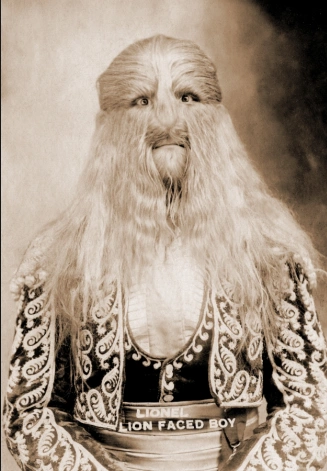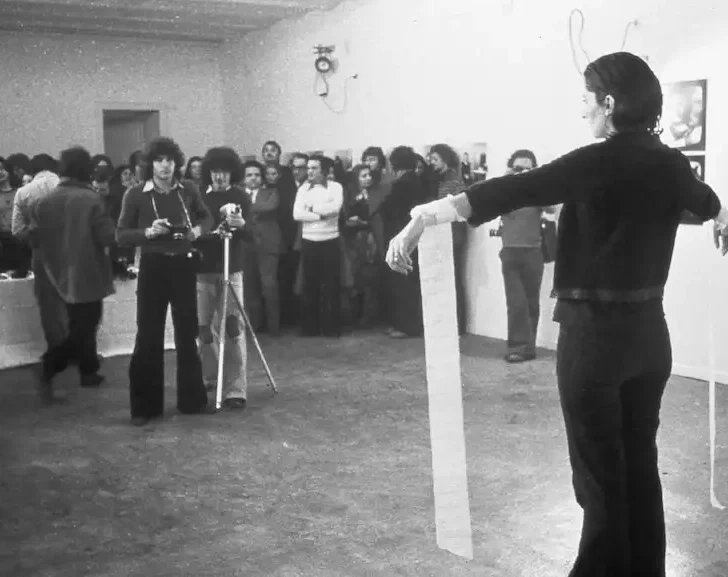Barnum & Bailey Circus dubbed itself “The Greatest Show on Earth.” The traveling circus featured trapeze artists, acrobats, clowns, and even a human cannonball.
In 1919, they joined forces with another big-name circus, the Ringling Brothers, and created a hugely popular entertainment show.
Part of the appeal of The Ringling Bros. and Barnum & Bailey Circus was the “freak show” it presented.


The circus allowed the paying public to see conjoined twins, bearded women, and dwarves. It would find those with biological rarities and exhibit them to shock, entertain—and make money.
One of the acts dubbed a “freak” was Stephan Bibrowski, who was given the stage name “Lionel the Lion-Faced Man.”
Stephan had a rare condition called hypertrichosis, which causes excess hair growth. At the time, this condition wasn’t understood, and so Stephan would be marketed as “half-lion, half-man” to entice circus-goers to see his act.
People would flock to see “Lionel” and his golden hair, which grew all over his body and was up to eight inches long on his face.
Many people knew him as Lionel, half-man, half-lion, but who was the man behind the act?
The Circus Finds Stephan Bibrowski
Born in 1890 to Benedetta Bibrowski in Wilczogóra, Poland, it became clear young Stephan wasn’t your average baby.
While pregnant, Benedetta had allegedly witnessed the horror of seeing her husband, Michael, killed by a lion. The disturbing attack, according to Benedetta, caused her son to be born with 2.5 centimeters of hair covering his body—and looking just like a lion.
Some sources suggest that the new mother struggled to come to terms with her child’s condition and that, by the age of four, she had decided to sell him to a circus manager named Sedlmayer.
Other sources have suggested that Benedetta was involved in her son’s life and never thought of him as an “abomination,” as some news outlets reported.
Either way, from a very young age, Stephan became part of the circus and traveled all over the world as Lionel.
By all accounts, Stephan flourished as he grew up in the circus. He enjoyed the attention he received as half-boy, half-lion and the purpose that circus life gave him.
In 1901, when Stephan was around 11, Stedlmayer took him to the United States and began exhibiting him at sideshows.
Each night, Lionel and his long locks were the star attraction at various boardwalks on the East Coast. One night, while performing, the boy was noticed by talent scouts who worked for the Barnum & Bailey Circus.

The scouts struck a deal with Stedlmayer, and Stephan, still using the name “Lionel,” was Barnum & Bailey’s newest attraction. His act matured at this point, and instead of simply ogling Stephan and his unique condition, people were treated to his acrobatics.
Not only that, they got to talk with the boy, who, despite his young age, was full of charm and chatter.
Whereas many of the other acts would shy away from conversing with the audience— after all, they were dubbed “freaks” by the very organization they worked for—Stephan loved interacting with the audience.
As the years passed, The Ringling Bros. and Barnum & Bailey Circus eventually joined forces and grew in popularity. It even dubbed itself “The Greatest Show on Earth.” Here, Lionel became a star attraction.
People flocked to see the long, golden hair that enveloped his body. Every inch of him was covered, aside from the soles of his feet and the palms of his hands.
Circus-goers believed that the acts had been plucked from impoverished or poor conditions and were given a second chance at life by the circus. While this was rarely the case, for Stephan, it seemed the carnival life gave him genuine enjoyment.
Life on the road did nothing to dispel Stephan’s thirst for knowledge, either. He could speak five languages and had aspirations to become a dentist once his circus life came to an end.
Still, few people knew—or cared to know—the man behind the hair. Stephan was simply another “freak” on the circus’ lineup to most.
For the next two decades, Stephan performed in the circus, traveling the world with other acts he called his friends.
The Greatest Show On Earth
Marketed as “The Greatest Show on Earth,” the amalgamation of The Ringling Bros. and Barnum & Bailey Circus brought amusement and rare sights to the cities it visited. From exotic animals doing tricks to acrobats to fire eaters, the show became the pinnacle of entertainment.
One of the circus’ biggest draws was the “freaks” it exhibited. Often, these acts were people with disabilities or biological deformities and were little more than a paycheck for the circus promoters.
Acts were frequently treated like property, and their promised riches weren’t always delivered. One such case was George and Willie Muse—“The Men From Mars.”
The young brothers were black albinos who’d been stolen from their parents by a “freak hunter” who sold them to the circus.
The boys were told their mother had died to stop them from running away. In reality, she was very much alive and looking for her children.
When George and Willie spotted their mother in the audience at one of their shows, they immediately knew they’d been lied to and were reunited with her. It was only then they broke free from their captors.
The Ringling Bros. and Barnum & Bailey Circus also mistreated animals for their shows. In fact, P.T. Barnum was responsible for the enduring myth that elephants could not feel pain through their thick skin. This belief had seen the animals hit with sharp bullocks to coerce them into performing the act.
Over the years, many animals died while being used or transported by the circus, something that was less of a concern for the audiences in the 1920s, when the circus was at its popularity peak.
Nowadays, however, the circus no longer uses animals as part of its act after many fines and protests from PETA over its treatment of animals.
The dark side of the circus, however, didn’t seem to affect Stephan Bibrowski. As promised, he made good money, was well-treated by his promoters, and enjoyed traveling.
Unlike other acts, he didn’t become insular or develop a dislike of the people who paid to see him—quite the opposite, in fact.
Stephan, The Man
When he was 30, Stephan eventually settled in New York, where he performed at a pop-up on Coney Island.
It was here that the real man behind the act was able to shine. The intimate setting allowed Stephan to wander through the crowd and speak to the paying customers.

To their surprise, Stephan—or Lionel as they knew him—wasn’t aggressive or monstrous as promoters had portrayed him to be.
In fact, he was kind, gentle, inquisitive and intelligent. Stephan was short in stature and meek in nature, much to the surprise of many. It has been said that once people got talking to Stephan, they forgot all about the hair that covered his body.
Stephan was fiercely protective of the unusual hair that covered him. The hair on his head was about eight inches long and about four inches everywhere else. He felt the condition made him interesting and allowed him to be someone extraordinary.
On one occasion, while Stephan was staying in a New York City hotel, a fire broke out in the building. As the alarms went off, it was alleged that Stephan was one of the first evacuees.
Stephan would later say that if his long locks were burned off or even singed in the fire, he would no longer be special—he’d just be “an ordinary man.”
In the late 1920s, Stephan decided to retire altogether and moved to Germany. Sadly, his story doesn’t go much further than this—he died in Berlin from a heart attack in 1932, aged just 41.
While Stephan never got to carry out his dentistry dreams, he will forever be remembered for his unique act and ability to connect with his audiences.
Although Stephan was undeniably extraordinary, there are other cases of people with hypertrichosis in the circus. One was called “Jo-Jo the Dog-Faced Boy.”
Hypertrichosis And The Circus
Jo-Jo’s real name was Fedor Jeftichew, and he was born in 1868 in Russia. He was brought to the USA when he was a teenager by P.T. Barnum.
Fedor was born with hereditary hypertrichosis, which caused Barnum to create an interesting backstory for his “Jo-Jo” character. In a bid to entice crowds, the story goes that the “dog-faced boy’s” father lived in a cave in the forest before being captured by a hunter.
When the hunter was unable to tame the “wild dog,” he killed it.
However, this was far from the truth. In reality, Fedor’s father was alive and well and even performed his own show. However, he developed alcoholism and eventually drank himself to death.
Fedor’s act saw the boy forced to bark on stage for the baying crowds. Circus-goers would describe him as “playful like a puppy” despite him being a normal, human teenage boy.
In more recent times, there’s the case of Jesus Aceves, born in Mexico in 1968. He found work in the circus from an early age, and much like Stephan and Fedor, he was marketed as a “freak” and “wolf man.”
However, times have changed, and Jesus no longer wishes to be exhibited as a “freak” and chooses not to travel with the circus. These days, the circus focuses more on acrobatics, juggling, acting, comedy, and magic than on exhibiting “freaks.”
For Stephan Bibrowski, this would be a disappointment: the circus gave him purpose and made him “extraordinary.”
Sources
https://www.bklynlibrary.org/blog/2021/06/03/lionel-lion-faced-man
https://www.spiegel.de/geschichte/phaenomen-freakshows-a-947387.html
https://cabinetofcuriosities.ca/stephan-bibrowski-lionel-the-lion-faced-man
https://www.thehumanmarvels.com/lionel-the-lion-faced-boy
https://repozytorium.umk.pl/bitstream/handle/item/3052/7.pdf?sequence=1












Leave a comment